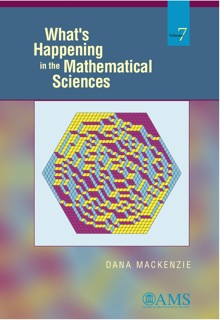What’s Happening in the Mathematical Sciences, Volume 7 covers the period from 2006 to 2008. Below is an annotated table of contents.
- A New Twist in Knot Theory
Two seemingly unrelated kinds of knots — modular knots and Lorenz knots — turn out to be the same. For number theorists, the payoff is a new way to look at an old concept, the modular surface. For dynamical systems theorists, it’s a new way to understand the beginnings of chaos.
Branch of mathematics: Dynamical systems, number theory.
- Error-Term Roulette and the Sato-Tate Conjecture
Fifteen years ago, Andrew Wiles proved Fermat’s Last Theorem, thereby solving the most famous problem in mathematics. The aftershocks are still being felt. A team of number theorists, including Wiles’ collaborator, Richard Taylor, adapts Wiles’ machinery to polish off another celebrated unsolved problem.
Branch of mathematics: Number theory.
- The Fifty-one Percent Solution
Persi Diaconis, Susan Holmes, and Richard Montgomery tell you how to get the odds in your favor the next time you flip a coin. And no, you don’t have to cheat.
Branch of mathematics: Mathematical physics, differential geometry.
- Dominos, Anyone?
An innocent puzzle about tiling a checkerboard with dominos leads, ultimately, to a new model of random surfaces. The theory is both simple enough to be exactly solvable, and complex enough to include phase transitions between “solid,” “liquid,” and “gaseous” states — a combination that has never occurred previously in statistical physics.
Branch of mathematics: Statistical physics.
- Not Seeing is Believing
New “metamaterials” may soon bring invisibility cloaks — and inaudibility cloaks, too — out of the realm of fantasy and into reality. Unlike Harry Potter’s cloak, these devices will work strictly on the principles of mathematics, not magic.
Branch of mathematics: Applied mathematics.
- Getting with the (Mori) Program
The Mori Minimal Model Program is an ambitious effort to match the geometry of surfaces defined by polynomial equations to their algebra. After 100 years of carrying out the program one dimension at a time, algebraic geometers race to the top of the ladder.
Branch of mathematics: Algebraic geometry.
- The Book that Time Couldn’t Erase
More than 1000 years ago, an unknown scribe copied some of Archimedes’ works onto parchment. But 200 years later, another scribe erased them and wrote a prayer book over the top. Over the last ten years, high-tech imaging methods have penetrated through the damage done by centuries of neglect and abuse to reveal what Archimedes, the greatest mathematician of ancient Greece, really wrote.
Branch of mathematics: Geometry, combinatorics, mathematics history.
- Charting a 248-Dimensional World
Racing against time and the incurable illness of one of their colleagues, a team of twenty group theorists puts together a detailed survey of “the most beautiful structure in mathematics” — the exceptional Lie group, E8.
Branch of mathematics: Algebra.
- Compressed Sensing Makes Every Pixel Count
Proving that more is not always better, mathematicians show that “sparse” or “compressible” signals, such as digital photographs and cell-phone messages, can be reconstructed from many fewer measurements than engineers previously supposed. As an extreme proof of principle, engineers design the world’s first single-pixel camera.
Branch of mathematics: Applied mathematics.
Cover picture: A random tiling of a hexagon by lozenges. (See Chapter 4.)




